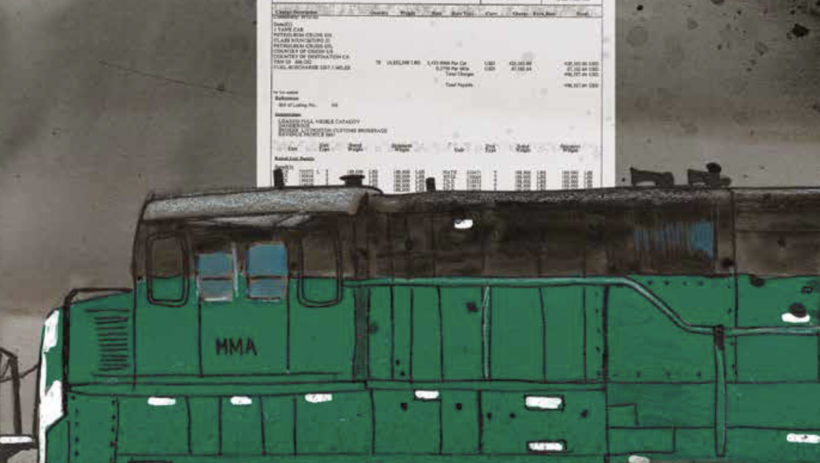Ten years since Mégantic: the sad telling of a perfect capitalist story

Today marks the tenth anniversary of one of the deadliest rail disasters in Canadian history: on July 6, 2013, a runaway train loaded with explosive oil derailed in the small town of Lac-Mégantic, Québec, claiming forty-seven lives and destroying the town’s centre.
A decade after the Mégantic tragedy, there has still been no national inquiry into its causes and no changes to Canadian rail safety rules. Instead, the survivors have been left to the mercy of predatory developers as they rebuild their town, a poignant example of how the powerful profit from collective tragedy. Sadly, this story remains relevant with the recent rail disaster in East Palestine, Ohio, proving the point that corporate malfeasance in the rail industry continues apace.
To commemorate the anniversary of this tragic train disaster in the Québec town of Lac-Mégantic, we are publishing here an excerpt from A Train in the Night, a graphic nonfiction book about the disaster written by journalist Anne-Marie Saint-Cerny and illustrated by artist Christian Quesnel. The following excerpt is the book's epilogue, written by Anne-Marie.
Anne-Marie Saint-Cerny is an award-winning writer and activist who was on the scene in Lac-Mégantic just days after the disaster. Her investigative journalism detailed the train derailment and its aftermath, tracing the path of the locomotive from the scene of the crime all the way back to cowboy producers of Dakota black gold, Wall Street investors, and politicians in the pocket of the billion-dollar oil and gas industry. This important work is a powerful reminder that behind the narrative of ‘accidents’ and ‘individual blame’, there is the haunting reality of the crimes of capitalism – and the true human cost of prioritizing corporate profit over community safety.
A Train in the Night: The Tragedy of Lac-Mégantic
I arrived in Lac-Mégantic five days after Night Zero. The ruins were still red hot, smoking, giving off a smell—surely imaginary?—of scorched human flesh. No one yet knew how many souls had taken flight. They were forty-seven, as we would soon learn. As the years passed, a few shattered souls were added to the list: suicides.
I had gone there because, from the start, a suspicious discrepancy was emerging between the official statements and the facts revealed by a simple internet search. Intense pollution, survivors stunned by the impact, the lies and half-truths that were beginning to circulate... After twenty-five years of activism, I was all too able to recognize the picture, though this one was a hundred times more brutal, with predators eager for profits, governments complicit in avoidable tragedies, and victims left to their own resources.
But that wasn’t the end of it. Such tragedies, when they occur, set off a cycle of dramas that seems fated to never end. For instance, one day in early February, the Town of Lac-Mégantic demolished more undamaged houses than the inferno itself. Impoverished tenants, little beauty salons, were swept away to make room for modern grocery chains and new condominiums. It was an all-too-familiar capitalist story.
Where did all that evil originate? From the start the only official explanation was a simplistic one: The disaster was blamed on the error of just one man, alone in the mountains, who was alleged to have applied an insufficient number of brakes when parking his train. And from the start I decided that this time I would uncover the truth: Who had made it possible for one man, by himself, a single employee on the bottom rung of the hierarchy, to be allowed to leave the keys on the seat of a locomotive hauling seventy-two bombs along defective track and to leave it running all night?
This initial investigation was published in French in my book Mégantic: Une tragédie annoncée in June 2018, shortly before the fifth anniversary of the tragedy. (An English translation, Mégantic: A Deadly Mix of Oil, Rail, and Avarice, followed in 2020.) I had promised my friends in Mégantic that I would get answers. But I had underestimated the scope of the undertaking. For, to this day, the Canadian government, which is supposed to oversee the railway industry, has rejected out of hand every request for a public inquiry into a tragedy that cost so many lives and destroyed half of a little town. The victims never got any answers, and the risk remains as great as ever, for trains still travel by night through the very heart of the town. The promised bypass line will be even more dangerous and require further expropriations. And the danger is the same all over North America. As for the railway industry, it remains protected and prosperous.
The Mégantic book did provide some answers, but it could not bear adequate witness to the lives lost or destroyed. It could not bring back the faces, the terrified, haggard expressions, the indescribable sorrow. Nor could it explain how this tragedy became part, symbolically, of the incalculable suffering inflicted on some human beings by others, whether out of pure indifference or in pursuit of financial reward. Humans suffer and die because of other humans, whether in Mégantic or Bhopal, some as victims of war, some drowned as migrants. They suffer because some powerful individual or group has refused to make improvements, to negotiate, to sign some document—an order, a treaty, a truce, whatever.
Digging up the truth is one of the few weapons at our disposal to prevent the recurrence of preventable horrors. That is how this graphic book, inadequate yet not entirely useless, sets out to combat avoidable suffering.
— Anne-Marie Saint-Cerny, June 2021

